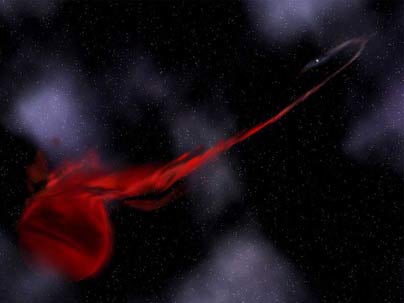This article is more than 1 year old
Space watchers spot pulsar eating a star
Skeleton star gets gobbled
Astronomers using NASA's Swift and Rossi X-Ray Timing Explorer (RXTE) satellites have discovered a stellar skeleton, a remnant of a dying star that is being consumed by its pulsar companion. So little of the star's original material is left that it now barely masses more than Jupiter.

Artist depiction. A pulsar tears into a planet mass object.
Credit: Aurore Simonnet, Sonoma State University
The artist's impression shows material being torn from a tear drop shaped blob in the foreground, flowing in a stream into the pulsar in the upper right corner. The planet-sized collection of helium is all that remains of the star. As its outer layers are pulled away, the material builds into a disk around the pulsar. Eventually, this material produces an outburst that can be seen from Earth.
The light from such an outburst reached Earth this June, which is when astronomers became aware of the system, some 25,000 light years from our sun.
NASA says the SWIFT J1756.9-2508 system is one of the most bizarre objects ever discovered in space. The observations from the RXTE satellite suggest the pulsar, which contains roughly 1.4 solar masses, is about 10 miles in diameter, and is spinning 182.07 times per second.
"This means that the surface of the star is moving at about 7000 miles per second, or roughly four per cent the speed of light," said Deepto Chakrabarty, an associate professor of physics in MIT's Kavli Institute for Astrophysics and Space Research. "While we already know of several cases of pulsars that have consumed or vapourised most of the mass in their companion star, SWIFT J1756.9 is possibly the most extreme example."
The scientists describe the likely history of the system. It probably formed several billion years ago, and consisted of a seriously massive star and a smaller companion. The huge star would have burned itself out and gone supernova relatively quickly, leaving behind the pulsar.
As the smaller star aged, it began to swell up as its internal pressure grew. It enveloped the pulsar, draining orbital energy from the system and causing the two objects to draw slightly closer together. Now the pair are closer together than the Earth is to the Moon, and the smaller star orbits the pulsar once every 54 minutes or so.
The team at MIT says observations of the system provide "a rare opportunity for astronomers to examine how millisecond pulsars are spun up to such incredibly rapid speeds, and to determine their eventual fate". ®
